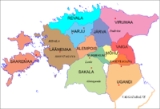
Lembitu of Lehola
Encyclopedia
Lembitu was an ancient Estonia
n elder of Sakala County and military leader in the struggle against conquest of the Estonian lands
by the German
Livonian Brothers of the Sword
at the beginning of the 13th century. He is the only Estonian pre-Crusade ruler, about whom some biographical information is known (he is mentioned only in the Chronicle of Henry of Livonia
).
Lembitu, also referred to in Latin
as Lambite, Lembito or Lembitus, was first mentioned in chronicles in 1211. Troops led by Lembitu destroyed a troop of missionaries in the historical Estonian county of Sakala and made a raid as far as Pskov
, then a town of the Novgorod Republic
. In 1215, Lembitu's Lehola (Leal) stronghold (situated near the present town of Suure-Jaani
) was taken by Germans and Lembitu was taken prisoner. He was released in 1217.
Lembitu attempted to unite the Estonians
in order to withstand the German conquest. He managed to assemble an army of 6,000 Estonian men from different counties, but was killed in the following Battle of St. Matthew's Day
in September, 1217.
Ancient Estonia
Ancient Estonia refers to a period covering History of Estonia from the middle of the 8th millennium BC until the conquest and subjugation of the Estonian people in the first quarter of the 13th century during the Northern Crusades.-The Mesolithic Period:...
n elder of Sakala County and military leader in the struggle against conquest of the Estonian lands
Livonian Crusade
The Livonian Crusade refers to the German and Danish conquest and colonization of medieval Livonia, the territory constituting modern Latvia and Estonia, during the Northern Crusades...
by the German
Germans
The Germans are a Germanic ethnic group native to Central Europe. The English term Germans has referred to the German-speaking population of the Holy Roman Empire since the Late Middle Ages....
Livonian Brothers of the Sword
Livonian Brothers of the Sword
The Livonian Brothers of the Sword were a military order founded by Bishop Albert of Riga in 1202. Pope Innocent III sanctioned the establishment in 1204. The membership of the order comprised German "warrior monks"...
at the beginning of the 13th century. He is the only Estonian pre-Crusade ruler, about whom some biographical information is known (he is mentioned only in the Chronicle of Henry of Livonia
Chronicle of Henry of Livonia
The Livonian Chronicle of Henry is a document describing historic events in Livonia and surrounding areas from 1180 to 1227. Apart from the few references in the Primary Chronicle compiled in Kievan Rus' in the twelfth century, it is the oldest known written document about the history of these...
).
Lembitu, also referred to in Latin
Latin
Latin is an Italic language originally spoken in Latium and Ancient Rome. It, along with most European languages, is a descendant of the ancient Proto-Indo-European language. Although it is considered a dead language, a number of scholars and members of the Christian clergy speak it fluently, and...
as Lambite, Lembito or Lembitus, was first mentioned in chronicles in 1211. Troops led by Lembitu destroyed a troop of missionaries in the historical Estonian county of Sakala and made a raid as far as Pskov
Pskov
Pskov is an ancient city and the administrative center of Pskov Oblast, Russia, located in the northwest of Russia about east from the Estonian border, on the Velikaya River. Population: -Early history:...
, then a town of the Novgorod Republic
Novgorod Republic
The Novgorod Republic was a large medieval Russian state which stretched from the Baltic Sea to the Ural Mountains between the 12th and 15th centuries, centred on the city of Novgorod...
. In 1215, Lembitu's Lehola (Leal) stronghold (situated near the present town of Suure-Jaani
Suure-Jaani
Suure-Jaani is a town in the northern part of the county of Viljandimaa in Southern Central Estonia, 25 kilometres north of the town of Viljandi. Suure-Jaani is the centre of Suure-Jaani rural municipality.-History:...
) was taken by Germans and Lembitu was taken prisoner. He was released in 1217.
Lembitu attempted to unite the Estonians
Estonians
Estonians are a Finnic people closely related to the Finns and inhabiting, primarily, the country of Estonia. They speak a Finnic language known as Estonian...
in order to withstand the German conquest. He managed to assemble an army of 6,000 Estonian men from different counties, but was killed in the following Battle of St. Matthew's Day
Battle of St. Matthew's Day
The Battle of St. Matthew's Day was fought near Viljandi on September 21, 1217 during the Livonian Crusade. The adversaries were the German crusading order the Sword Brethren with their recently converted Livonian and Latgalian allies and an army of 6000 Estonian men from different counties, led...
in September, 1217.
See also
- Caupo of TuraidaCaupo of TuraidaCaupo of Turaida, or Kaupo was a leader of the Finnic-speaking Livonian people in the beginning of the 13th century, in what is now Latvia. He is sometimes called 'King of Livonia', Chronicle of Henry of Livonia calls him quasi rex, 'like a king'.He was the first prominent Livonian to be christened...
- Livonian CrusadeLivonian CrusadeThe Livonian Crusade refers to the German and Danish conquest and colonization of medieval Livonia, the territory constituting modern Latvia and Estonia, during the Northern Crusades...
- Rulers of Estonia
- SackaliaSackaliaSakala County was an ancient Estonian county first mentioned in print by Henry of Livonia in the beginning of the 13th Century....
- Vetseke

